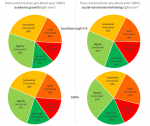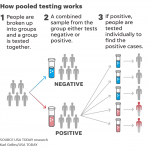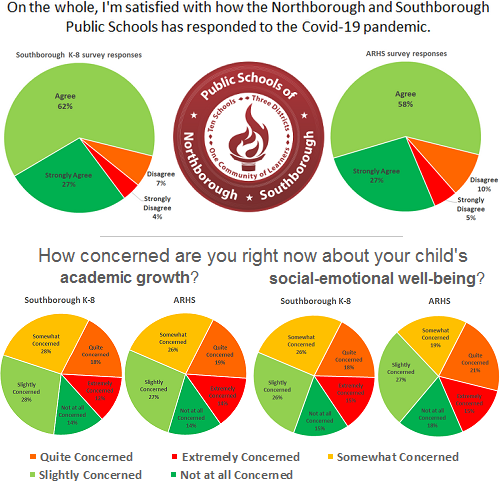Above: Most parents of Southborough K-8 and Algonquin students (who responded to the survey) indicated they were satisfied “on the whole” with the district’s pandemic response but still worried about the impact to their children this year. (MySouthborough graphs based on district’s shared survey results)
NSBORO school committee meetings covered a lot of ground in the past two weeks. Presentations included overviews of parent responses to a survey issued in late November and updates and actions relevant to some of the concerns raised. Below are some of the highlights for Southborough K-8 and Algonquin.
Concern about students’ Learning and Well-Being
 As shown in the image right, over 80% of parents indicated they agreed with the districts’ handling of the Covid pandemic. However, that didn’t cut across all segments of the population.
As shown in the image right, over 80% of parents indicated they agreed with the districts’ handling of the Covid pandemic. However, that didn’t cut across all segments of the population.
33% of families with students in Algonquin’s SARP (Stand Alone Remote Program) disagreed or strongly disagreed with pandemic handling. Martineau noted that only 15 SARP families from Algonquin responded to the question.* The same percentage of that demographic indicated they were unsatisfied or only slightly satisfied with the school’s learning structure.
Comments in the survey indicated that parents chose the SARP model for their family for safety concerns, but found that the remote program paled in comparison to the in-person schooling. Similar sentiments were expressed by some Southborough K-8 SARP families.
 Overall, survey results showed that most parents of Southborough and Algonquin students were concerned about their children’s academic growth and social and emotional well-being this year. While there wasn’t a baseline to compare to traditional years, the impression was that is significantly higher due to pandemic impacts.
Overall, survey results showed that most parents of Southborough and Algonquin students were concerned about their children’s academic growth and social and emotional well-being this year. While there wasn’t a baseline to compare to traditional years, the impression was that is significantly higher due to pandemic impacts.
(Click images above right to see my graphs summarizing that data. For the full K-8 results with more questions and details, click here. For the ARHS presentation, click here.)
Social & Emotional Impacts
Administrators acknowledged that Covid restrictions have hampered students’ social interactions this year. Finding safe ways to increase that is something the schools have been working on.
It’s worth noting that this week Trottier announced the launching of new club activities for students. The plan is to start off focusing on opportunities for 8th graders and expand down to lower grades. The school will offer a Basketball program for 7th & 8th graders (not competing with other schools), a Drama program (for a production to be filmed), and Big Band. To help that effort, they sought feedback on interest in a late bus. The school is also offering a virtual Book Club and a Baking Club.
(Algonquin has already been offering clubs and sports, while Southborough Recreation has been offering after school programs for K-5 students.)
Academic Growth Impacts
At both the Southborough and Regional School Committee meetings, administrators addressed the way teachers are striving to ensure students meet important academic benchmarks. One of the challenges pointed to was the 10 days lost at the start of school to allow additional Professional Development. (Though, administrators noted the importance and usefulness of that effort.)
Algonquin Principal Sean Bevan also pointed to shorter academic hours due to increased time for students to safely transition between classes, and a longer lunch period to allow for cleaning between groups.
For K-8 Academics, Assistant Superintendent Stefanie Reinhorn assured last week that students are doing fairly well based on key benchmarks. But she acknowledged they aren’t quite where they would hope to be in a normal year.
Reinhorn shared that the majority of “are on par in [math topic ] assessments” though “in some grades fact fluency and automaticity is not on par with years past”. For English Language Arts, the majority “are reaching benchmarks for the time of year” though “some areas harder to assess and support remotely”. Additionally teachers would rather use in-person time for teaching and not spend too much of it on assessments.
Reinhorn explained the district’s process for prioritizing the traditional curriculum to focus on covering the most important topics. She pointed out that many of the topics students learn in the lower grades are touched upon multiple times over years. That means that some of the teaching given less depth this year can be reinforced in future years.
Bevan addressed the pandemic impact on learning to the Regional School Committee this week. That included their teachers’ approach to prioritizing curriculum.
The ARHS Principal also acknowledged that teachers will have to assume incoming students next year have less depth of knowledge than a traditional class. His overall finding was that the learning loss from Spring 2020 was less than they expected and had been “mitigated”. But he stressed that the measures to achieve that aren’t sustainable long term.
In an earlier presentation, Science Department teachers explained that some of the longer labs have been replaced with videos and some of the labs/lessons that had higher enjoyment for teachers/students but were less efficient for learning have had to be cut this year. They have also had to sacrifice some depth of learning. The depth issue also impacts Applied Arts where students don’t have specialized equipment at home.
Science, math, and world language teachers are focusing on topics/skills students will need to proceed to the next level of education. English is focusing on the same concepts and skills but with fewer texts. Social studies is focusing on the same content but using shorter assessments.
Algonquin students have complained that too much of their in-person attendance has been dedicated to assessments/tests. It’s something Bevan is looking into with teachers. One way he hopes to reduce that is through increasing use of open notes tests. That would allow both hybrid and in-person cohorts to fairly take tests at the same time.
For K-12 Hybrid teaching, one silver lining this year has been smaller in-person classrooms. Teachers indicated it allowed them to get to know and assess students better. On the flip side, there have been concerns from SARP (remote only) families about their larger classroom sizes. (You can read more about that staffing issue here.)
Remote and asynchronous lessons also make it harder for teachers to assess how students work on their own. One example given for lower grades was handwriting, where teachers are unable to see and correct students’ pencil grips and where they place the pencil to start a letter. Those kinds of issues have required greater support from and communication with parents.
(You can view the full K-8 discussion here and read the presentation here. You can view the ARHS discussion here.)
Evaluating Risk of Increased In-Person Attendance
For parents unhappy with the districts handling of the pandemic, comments highlighted the lack of consensus on in person attendance. There were some who felt that the school shouldn’t be holding in-person classes. Others opined that kids should be in school 5 days per week.
Survey Results for potential Hybrid Changes
The administration is looking at data to plan ahead for potential increased attendance this spring. To that end, K-5 parents were surveyed on how they would react if the school offered more in-person attendance. (Over the summer, in developing a phased reopening plan, the administrative team made clear that they believe in-person schooling is a higher priority for the lower grades. But discussions at this month’s committee meeting indicated the district is looking at the eventual potential for the full K-12 population.)
Two questions were posed related to increasing Hybrid attendance from 2 days per week to 4 days per week.
 Based on survey results, if the school maintained the same level of social distancing, 90% of Southborough K-5 parents would keep their children in their current programs. Of those who would switch programs, more parents would move students into Hybrid than out of it.
Based on survey results, if the school maintained the same level of social distancing, 90% of Southborough K-5 parents would keep their children in their current programs. Of those who would switch programs, more parents would move students into Hybrid than out of it.
 The results were different when parents were asked about reducing social distancing from 6 feet to “3-6 feet” to make increased attendance happen. In that instance, 16% of families would switch programs with the majority switching to the remote program.
The results were different when parents were asked about reducing social distancing from 6 feet to “3-6 feet” to make increased attendance happen. In that instance, 16% of families would switch programs with the majority switching to the remote program.
Martineau noted to committee members that surveying families was important since it wouldn’t make sense to increase in-person opportunities for those attending if 80% switched out of attending. Prior to making any changes, the district would work to educate parents on what changes would mean.
The 3-6 feet standard is consistent with the state’s guidelines. This summer, the district administration and Medical Advisory Team stated that wasn’t a safe enough standard. Since the districts’ schools don’t allow for all students to attend while maintaining a 6 foot distance, the administration opted to pursue Hybrid attendance.
Now the district is looking at new data measures to make more informed decisions this spring.
Calculating Classroom Risks
At this month’s meetings, Operations Director Keith Lavoie explained that they are working to better evaluate the risk involved in making changes. The district has partnered with an engineering firm, CANNON Design. They are working on a “calculator” to help the administration and parents understand risks on a classroom by classroom level.
The tool would incorporate factors for each classroom, including HVAC/air exchange, distance between desks, number of students, and the Towns’ community transmission levels.
Southborough committee member Jessica Devine asked if the calculator would take into account the new highly contagious strain. Lavoie said the issue was raised with the engineers who were thinking about it. Wellness Director Mary Ellen Duggan clarified that the Towns don’t have data on which strains residents are infected with. She believed changes in health metrics/transmission levels for the community were how that would be accounted for in calculations.
Screening Students for Covid
One factor that parents weren’t yet aware of when they answered the survey was a plan to introduce weekly Covid-19 Screening for students.
 At this month’s meetings, Duggan laid out the plan. The program would be optional with each student offered self-administered testing kits to take home. (Though, presumably parents of younger students would administer it for them.) The tests require swabbing inside the nostril, not uncomfortably high up. (See image right from email issued this evening.)
At this month’s meetings, Duggan laid out the plan. The program would be optional with each student offered self-administered testing kits to take home. (Though, presumably parents of younger students would administer it for them.) The tests require swabbing inside the nostril, not uncomfortably high up. (See image right from email issued this evening.)
The district isn’t utilizing the state’s program for schools. The state’s program would require nurses oversee each test. Martineau said that would require dedicating all of the district’s nursing staff to that one task and nothing else.
NSBORO issued an RFP to find the lab they are using. The costs will be covered by CARES Act funds through the Towns of Southborough and Northborough.
 Once a week, participating students would use the test, place the swab in its plastic test tube, and bring the test to school where a QR code would be scanned to identify the student. (For those who forget their kits at home, the schools will have extras on hand.)
Once a week, participating students would use the test, place the swab in its plastic test tube, and bring the test to school where a QR code would be scanned to identify the student. (For those who forget their kits at home, the schools will have extras on hand.)
The lab is set up to use the swabs to conduct 16 PCR tests at a time, with the same sensitivity as an individual test. If something comes back positive, each swab would be individually tested to identify which one(s) were positive. (In contrast, the state test requires the schools to pool the swabs prior to sending them to the lab. That means that for any batches that came back positive, 16 tested individuals would have to be tested again.)
The plan is to pilot the testing at one school by early February, then expand across all NSBORO schools the following week. (That was confirmed in an email to parents tonight, with a link to a sign up sheet to enroll students in the program. Last week, an email shared FAQs on the program.)
Regional Committee Member Paul Desmond noted that only about 500 Algonquin students participated in previous screening offers. He wondered what percent was needed to be effective.
Duggan said that they really need 80% of the schools in order to track what’s happening in the population. (That’s more than double.) She followed that in other districts where testing was offered participation grew over time. That was something they saw with their own staff tests which started with about 400 participants and has grown to well over 700.
At another point, the administration indicated that staff testing increased it shifted from a central point at Algonquin to being offered at each individual school. Similarly, the new screening program will be more convenient for students than the one previously offered for the high schoolers.
The December and early January tests required students to make appointments to come into the school on a day that they were schooling from home. Duggan hoped that since students would receiving and returning kits in on days they are already attending, interest in the new program will be higher.
Regional member Chris Covino asked Martineau to stress to the public the importance of participating in screening if they want to increase in-person learning opportunities.
Martineau also noted that he’s hopeful the rollout of vaccinations to district teachers will line up well with plans to increase students in classrooms. Upon questioning during the Southborough School Committee, the Superintendent reassure that he doesn’t plan to hold up increased attendance plans if the vaccine roll out doesn’t go as hoped.
The bottom line was that while nothing is certain, the district is preparing to be able to make data driven decisions this spring.
*18 ARHS SARP student-families responded to the survey, but not all survey participants answered each question. Enrollment figures from September indicated about 82 ARHS students were enrolled in SARP, so the response is about 18% of that group. In contrast, it appears about 42% of ARHS Hybrid student-families responded.



Thank you for this very thorough update, Beth!